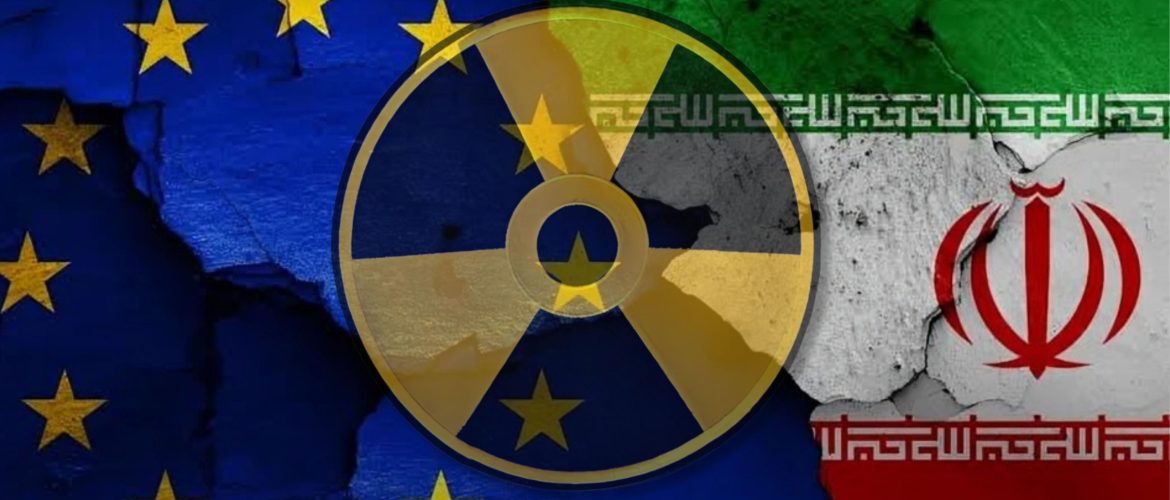Articles
مركز شاف لتحليل الأزمات والدراسات المستقبلية > Reports > Middle East Unit > “Snapback” Mechanism: A Final Deterrent or Gateway to Escalation with Iran?
“Snapback” Mechanism: A Final Deterrent or Gateway to Escalation with Iran?
- July 17, 2025
- Posted by: Maram Akram
- Category: Middle East Unit Reports
No Comments

Prepared by/ Dina Ehab
Research Assistant in the Middle East Affairs Unit
Amid escalating regional and international tensions surrounding Iran’s nuclear file, the “snapback” mechanism—formally known as the automatic reimposition of UN sanctions—has re-emerged at the forefront of political and diplomatic discourse, following mounting European threats against Tehran. On Tuesday, July 15, 2025, French Foreign Minister “Jean-Noël Barrot” declared that France would not hesitate to activate this mechanism should efforts to reach an agreement on Iran’s nuclear program fail, affirming that the E3—France, Germany, and the United Kingdom—retain the right to reimpose sanctions on arms, the banking system, and nuclear equipment that had been lifted ten years ago.[1] This statement coincided with the German Chancellor’s announcement of his country’s intention to formally submit a request to the UN Security Council to trigger the same mechanism, in a clear indication of Europe’s increasingly hardline position in response to the stalled negotiations with Iran. In turn, Tehran categorically rejected these threats, describing any potential activation of the snapback mechanism as an unjustified escalation that lacks legal and moral grounds and reflects, in its view, a hostile political posture by the European states. Iran also asserted that it would respond to any such move accordingly, [2]signaling the beginning of a new phase of mutual escalation and raising fundamental questions about the legal validity, the limits of effectiveness of this mechanism in confronting Iran, and the possibility of containing the crisis within current diplomatic frameworks.
Firstly: The Framework of the “Snapback” Mechanism
The “Snapback” mechanism is considered one of the most prominent legal tools in the Iranian nuclear dossier, as it combines procedural power with high-stakes political impact, as outlined below:
1- Origins under the Obama Administration:
The roots of the Snapback mechanism date back to former U.S. President Barack Obama’s administration, which negotiated the Joint Comprehensive Plan of Action (JCPOA) with Iran in 2015 in coordination with the five permanent members of the UN Security Council, along with Germany, within the multilateral framework known as the P5+1. The U.S. administration at the time insisted on embedding the Snapback clause within UN Security Council Resolution 2231 as a means of safeguarding the agreement from any future obstruction, [3] particularly by Russia or China. The mechanism was designed to ensure the implementation of the deal’s provisions through an implicit threat of the swift reimposition of UN sanctions in case of Iranian non-compliance. However, this legal instrument—which remained unused during Obama’s tenure due to Iran’s relative compliance—functioned more as a diplomatic safety net than a tool for direct confrontation.
2- The Procedural Function of the “Snapback” Mechanism:
The Snapback mechanism possesses a unique procedural sensitivity that renders it one of the most potent legal instruments within the UN system. If any party to the nuclear agreement submits a formal complaint to the Security Council claiming a “significant breach” by Iran, the Council is granted a 30-day window to vote on a draft resolution that would uphold the suspension of sanctions. [4] The critical paradox of this mechanism lies in the fact that the complaining state can veto this resolution, thereby automatically triggering the reinstatement of all previous UN sanctions without requiring any further vote. In this sense, the mechanism entails an almost automatic reactivation of the sanction’s regime, contingent on the political will of a single party. The steps required to activate the mechanism are as follows:
The party that believes Iran is in non-compliance submits a written complaint to the “Joint Commission,” composed of representatives from all signatory states to the agreement.
The Commission is given a 15-day period to resolve the dispute through negotiations.
If the issue remains unresolved, the matter is escalated to the foreign ministers of the participating countries, who are granted an additional 15 days for discussion.
During this period, the complaining party may—though it is not obligated to—request an opinion from a three-member advisory panel of experts, which must deliver its findings within 15 days.
If all these steps fail to yield a resolution, the complaining party may refer the case to the UN Security Council.
A draft resolution is then submitted to the Council affirming the continued lifting of sanctions on Iran.
If the Security Council fails to adopt the resolution within 30 days, all international sanctions previously imposed on Iran are automatically reinstated.
